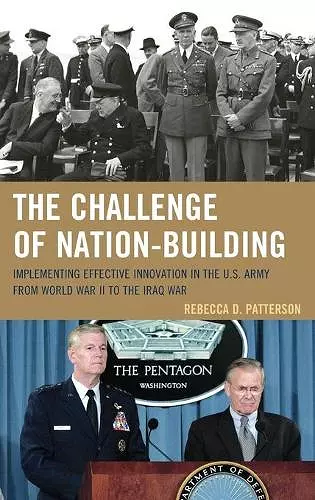The Challenge of Nation-Building
Implementing Effective Innovation in the U.S. Army from World War II to the Iraq War
Format:Hardback
Publisher:Bloomsbury Publishing PLC
Published:17th Sep '14
Currently unavailable, and unfortunately no date known when it will be back

In the last decades, the United States Army has often been involved in missions other than conventional warfare. These include low-intensity conflicts, counterinsurgency operations, and nation-building efforts. Although non-conventional warfare represents the majority of missions executed in the past sixty years, the Army still primarily plans, organizes, and trains to fight conventional ground wars. Consequently, in the last ten years, there has been considerable criticism regarding the military’s inability to accomplish tasks other than conventional war. Failed states and the threat they represent cannot be ignored or solved with conventional military might. In order to adapt to this new reality, the U.S. Army must innovate.
This text examines the conditions that have allowed or prevented the U.S. Army to innovate for nation-building effectively. By doing so, it shows how military leadership and civil-military relations have changed. Nation-building refers to a type of military occupation where the goal is regime change or survival, a large number of ground troops are deployed, and both military and civilian personnel are used in the political administration of an occupied country, with the goals of establishing a productive economy and a stable government. Such tasks have always been a challenge for the U.S. military, which is not normally equipped or trained to undertake them.
Using military effectiveness as the measurement of innovative success, the book analyzes several U.S. nation-building cases, including post World War II Germany, South Korea from 1945-1950, the Vietnam War, and Operation Iraqi Freedom. By doing so, it reveals the conditions that enabled military innovation in one unique case (Germany) while explaining what prevented it in the others. This variation of effectiveness leads to examine prevailing military innovation theories, threat-based accounts, quality of military organizations, and civil-military relations. This text comes at a critical time as the U.S. military faces dwindling resources and tough choices about its force structure and mission orientation. It will add to the growing debate about the role of civilians, military reformers, and institutional factors in military innovation and effectiveness.
The author has produced a direct and candid historical evaluation, enumerating the conditions that have allowed the U.S. Army to effectively innovate nation building in some cases, and also those instances in which the Army's efforts have not been successful.... This is a highly compelling approach and provides structure to a complex subject... The strength of the book is the historical analysis of each case that is thoroughly researched and referenced.... [T]hought provoking and revolutionary... The book should be required reading for all military and civilian leaders before sending future war fighters to foreign lands. * Army History *
Based on her historical analysis, Rebecca Patterson makes a persuasive argument that an effective innovation – in nation building but also in other non-conventional areas – depends on insightful military leaders unafraid to challenge the status quo and trustful civil military relations. Only with a military education and promotions systems that rewards innovative thinking and a more cordial political atmosphere will the US military be poised to adapt to 21st century challenges. -- Deborah Avant, Director of the Sié Chéou-Kang Center for International Security and Diplomacy, Josef Korbel School of International Studies, University of Denver.
ISBN: 9781442236943
Dimensions: 241mm x 161mm x 23mm
Weight: 526g
268 pages